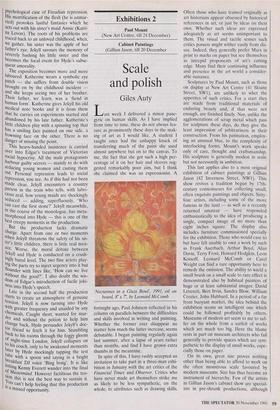Exhibitions 2
Paul Mount (New Art Centre, till 24 December) Cabinet Paintings (Gillian Jason, till 20 December
Scale and polish
Giles Auty
Last week I delivered a minor pane- gyric on human skills. As I have implied from time to time, these do not always fea- ture as prominently these days in the mak- ing of art as I would like. A student I taught once had the unhappy knack of transferring much of the paint she used almost anywhere but on to the canvas. To me, the fact that she got such a high per- centage of it on her hair and sleeves sug- gested remarkably poor aim, but I think she claimed she was an expressionist. A 'Nectarines in a Glass Bowl, 1991, oil on board, 8" x 7', by Leonard McComb fortnight ago, Paul Johnson reflected in his column on parallels between the difficulties and skills involved in 'writing and painting. Whether the former ever disappear no matter how much the latter increase, seems debatable. I began painting regularly again last summer, after a lapse of years rather than months, and find I have grown extra thumbs in the meantime.
In spite of this, I have rashly accepted an invitation to take part in a three-man exhi- bition in January with the art critics of the Financial Times and Observer. Critics who have never made art themselves strike me as likely to be less sympathetic, on the whole, to attributes such as drawing skills. Often those who have trained originally as art historians appear obsessed by historical references in art, or just by ideas on their own. Whether such ideas are expressed adequately as art seems unimportant to them. The visual and tactile senses such critics possess might wither easily from dis- use. Indeed, they generally prefer Marx in print to marks on paper but see themselves as intrepid proponents of art's cutting edge. Many find their continuing influence and presence in the art world a consider- able nuisance.
Sculptures by Paul Mount, such as those on display at New Art Centre (41 Sloane Street, SW1), are unlikely to whet the appetites of such critics. For a start they are made from traditional materials of enduring beauty and, if that were not enough, are finished finely. Nor, unlike the agglomerations of scrap metal which pass for sculpture these days, do they give the least impression of arbitrariness in their construction. From his patination, employ- ing an unusual blue, to the complexity of interlocking forms, Mount's work speaks only of care, thought and craftsmanship. His sculpture is generally modest in scale but not necessarily in ambition.
This last applies also to a most original exhibition of cabinet paintings at Gillian Jason (42 Inverness Street, NW1). This show revives a tradition begun by 17th- century connoisseurs for collecting small, often exquisite paintings and objects. Sixty- four artists, including some of the more famous in the land — as well as a recently returned amateur — have responded enthusiastically to the idea of producing a single, compact image of no more than eight inches square. The display also includes furniture commissioned specially for the exhibition. Those who would care to but have felt unable to own a work by such as Frank Auerbach, Arthur Boyd, Alan Davie, Terry Frost, Howard Hodgkin, Leon Kossoff, Leonard McComb or Carel Weight can find a rare opportunity here to remedy the omission. The ability to wield a small brush on a small scale to rare effect is demonstrated also by habitual painters of huge or at least substantial images: David Leverett, Bert Irvin, Sandra Blow, William Crozier, John Hubbard. In a period of a far from buoyant market, the idea behind the exhibition seems an intelligent one Which could be followed profitably by others. Museums of modern art seem to me to suf- fer on the whole from a surfeit of works which are much too big. Here the blame rests in part on museum architects who fail generally to provide spaces which are sym- pathetic to the display of small works, espe- cially those on paper.
On its own, great size proves nothing other than being able to afford to work on the often monstrous scale favoured by modern museums. Size has thus become an instrument of hierarchy. Few of the artists in Gillian Jason's cabinet show are special- ists in pre-shrunk productions, although Lucy Mackenzie, whose exhibition of highly accomplished micro-images opens at Fisch- er Fine Art on 4 December, is an experi- enced practitioner. Others demonstrate they can wield a No. 2 sable with all the panache of a distemper brush. The show travels on next summer to Hove Museum and Art Gallery and the Glynn Vivian Art Gallery and Museum in Swansea. Perhaps an enterprising museum somewhere should set out to collect and commission works in such limited, 'cabinet' dimensions by a wide variety of artists: in the meantime, memo- ries of what artists such as Turner could achieve on this scale should continue to haunt us all.











































































 Previous page
Previous page